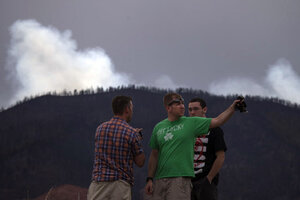Colorado Springs residents tour 'unreal' wildfire devastation
More than a week after it sparked on June 23, the Waldo Canyon fire was still being attacked by some 1,500 personnel.

Local residents (l.-r.) Scott Gregory, Ron Morgan, and Dylan Morgan monitor the Waldo Canyon Fire from a hill top in Colorado Springs, Colorado, on July 1.
Adrees Latif/Reuters
COLORADO SPRINGS, Colo.
Cars were burned to nothing but charred metal and only concrete remained of many homes in the neighborhoods most damaged by the worst wildfire in Colorado history.
But for residents allowed Sunday to temporarily return to the area for the first time since they fled encroaching flames last week, the fact that other things were left untouched was equally jarring.
"Good Lord! I've never seen anything like this," said C.J. Moore upon her return to her two-story home, now reduced to ashes and one of nearly 350 houses that were damaged or destroyed in the Waldo Canyon fire that left two people dead.
While searching for her great-grandmother's cast-iron skillets, Moore marveled at the juxtaposition of what burned and what hadn't. "To find my mail in my mailbox, unscathed. It's just unreal," she told The Associated Press by phone. "Bird baths are fine. Some of the foliage is fine."
More than a week after it sparked on June 23, the Waldo Canyon fire was still being attacked by some 1,500 personnel. Crews working grueling shifts through the hot weekend made progress against the 28-square-mile fire, and authorities said they were confident they had built good fire lines in many areas to stop the spread of the flames.
The blaze was now 55 percent contained.
It was just one of several still burning in the West, where parched conditions and heat contributed to the woes facing crews on hundreds of square miles across Utah, Montana, Wyoming and Idaho.
In Colorado Springs, a line of cars a mile long queued up at a middle school checkpoint, where police checked the identification of returning residents and handed them water bottles.
Not far away from Moore's home, Bill Simmons and his wife, Debbie Byes, returned to their tri-level, passive-solar stucco home and found no damage — just some ashes in the driveway.
"The water and electric's back on. You know, we're good to go," Simmons said by phone. "We're feeling pretty sad for our neighbors and pretty lucky for ourselves."
The house across the street burned to its foundation. It had a shake shingle roof. A house next door with shake shingles appeared undamaged, he said.
Unburned landscaping around the destroyed house suggested to Simmons that a stray ember rather than advancing flames was to blame. In all, three houses in their immediate neighborhood burned.
"It's crazy. The house across the street is burned to the foundation and the other side of the street is untouched," he said.
More evacuation orders were being lifted, which will bring the total number of people who remain blocked from their homes down to 3,000 from more than 30,000 at the peak of the fire.
Rich Harvey, incident commander for Waldo Canyon, said crews continue to make good progress.
"We're cautiously optimistic," he said Sunday.
The cause of the fire, which so far has cost $8.8 million to battle, has not been determined. Dangerous conditions had kept authorities from beginning their inquiry, but investigators were able to start work on Saturday.
A "bear invasion" confronted a few mountain enclaves west of Colorado Springs. The scent of trash had enticed black bears pushed out of their usual forest habitat by fire.
People who left in a hurry didn't take typical precautions to secure household trash against wildlife, said El Paso County Sheriff's Lt. Jeff Kramer.
"So that's become an attraction for the bears," Kramer said.
State game officials were trying to shoo the bears out, he said, and Dumpsters were stationed to help volunteers and returning homeowners throw stuff out. Kramer didn't know how many bears were causing problems.
Among the fires elsewhere in the West:
— Utah: Fire commanders say Utah's largest wildfire has consumed more than 150 square miles and shows no sign of burning itself out. Hundreds of firefighters are trying to hold the Clay Springs fire from advancing on the ranching towns of Scipio and Mills on the edge of Utah's west desert. The fire has destroyed one summer home and threatens 75 others. The fire was 48 percent contained on Sunday.
— Montana: Strong winds and high temperatures helped a wildfire near Lame Deer to grow by nearly 10 percent Sunday to 265 square miles. Authorities in eastern Montana called for evacuations as temperatures of about 100 degrees and winds of 20 to 30 mph pushed the Ash Creek Fire north and east toward homes and a campground.
— Wyoming: Late Sunday night, authorities called for evacuations in an area of southern Albany County where a fast-growing wildfire was burning. The area is about 30 miles southwest of Laramie in the Medicine Bow National Forest area. It wasn't immediately clear how may residences are affected. The blaze is one of several burning through parched forest lands in Wyoming.
— Idaho: Firefighters in eastern Idaho had the 1,038-acre Charlotte fire 80 percent contained Sunday but remained cautious with a forecast of high winds and hot temperatures that could put hundreds of homes at risk.
__ Nevada: More than 300 firefighters are battling a wildfire in a remote area of eastern Nevada. The 7,000 acre Egan Fire was burning about 9 miles south of the small town of Lund in the South Egan Wilderness.
__ New Mexico: A wildfire burning on the western border of Carlsbad Caverns National Park has grown to 5,000 acres. Officials said the fire is about five miles southeast of Queen and about a mile from the Carlsbad Caverns National Park boundary.

